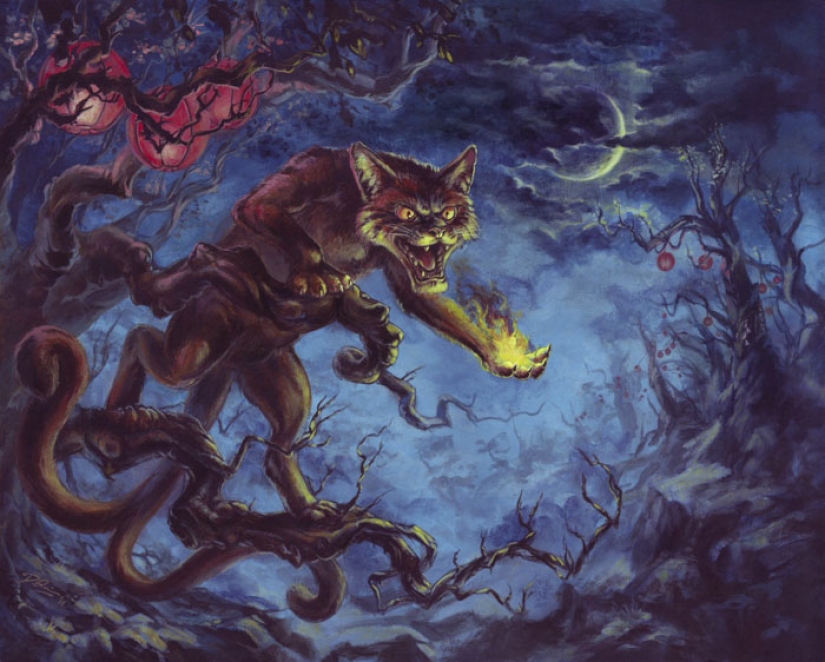The strangest mythological creatures in Japan
Categories: Asia | Culture | Lifestyle | People | Society | Tradition | Travel | World
By Vika https://pictolic.com/article/the-strangest-mythological-creatures-in-japan.htmlJapan has fairly rich folklore, and mythological characters play a very large role in it. Even today, the tales of these creatures are very fascinating, and they can be found almost everywhere, from manga and anime to video games.
We have collected some of the most interesting and terrifying mythological monsters in Japanese folklore.
11 PHOTOS

1. Nyoijizai.
Its only strength is its ability to scratch that itchy spot on your back that you can't reach no matter how hard you try.

2. Betobeto-San.
Betobeto-San follows the night traveler, making the sound of “beto beto” with his wooden sandals. It can be quite traumatic for the victims, but Bebebo-San is not dangerous. To avoid this monster, step back and say "After you, Betbeto-san."

3. Mokumokuren.
Mokumokuren is a ghost born from poorly functioning sliding doors (shoji). When the paper becomes riddled with holes, eyes begin to pop out of the holes, observing everything that happens inside your house. While this ghost is not dangerous, it is extremely creepy.

4. Shichinin Misaki.
Shichinin Misaki - ghosts of people who died in accidents. By killing one person, one of Shishinin Misaki's spirits can enter the world, and the one who was killed takes his place. For this reason, Shichinin Misaki is always a group of seven and never decreases or increases.

5. Futakuchi Onna.
This woman "has one normal mouth on her face and the other on the back of her head under her hair. In many stories, a second mouth appears on the woman's head to force her to eat more. Other stories say that the woman allowed her stepson to starve to death, and a vengeful spirit dwells in her body to take revenge.

6. Imori.
Imori is the ghosts of dead warriors transformed into geckos. They live in forgotten, overgrown ruins, where they died attacking and pursuing intruders.

7. Nekomata.
They look at people with contempt and are often responsible for summoning fireballs that start large fires, killing many people. They often control corpses with their necromantic abilities such as puppetry, and they use their powerful influence to blackmail or enslave humans in their quests.

8. Keukegen.
Despite his seeming cuteness, Keukegen is not good. They are actually a kind of spirit of failure, disease, and epidemics. They bring disease and ill health to those with whom they live. As a rule, they try to avoid contact with people, being shy by nature, and rarely meet.

9. Bake-Kujira.
Bake-kujira is a huge ghostly skeleton whale. They appear on rainy nights near Japanese coastal whaling villages, frightening fishermen and carrying a powerful curse to anyone who sees it. The curse of the whale brings famine, plague, fire, and other forms of disaster to the villages it finds itself in.

10. Gashadokuro.
Gashadokuro is spirits that take the form of giant skeletons fifteen times the height of the average human, and are said to be made up of accumulated human bones that died of hunger or war while unburied. They wander after midnight, grabbing lone travelers and biting off their heads to drink their blood.

11. Kami-Kiri.
Kamikiri is a monster with a beak and hands like razors. They are small and able to sneak quietly through open windows and doors without disturbing their victims. At night, they sneak up on the victims and cut their hair.
Keywords: Japan | Mythological creatures | Fairly rich folklore | Manga | Anime | Beliefs | Myths | Society | Culture | Religion
Post News ArticleRecent articles

Now more and more people are switching to proper nutrition, because healthy food is the key to a healthy life. But if you have been ...

The founder of the project "Healthy moms" Rhian Allen (Rhian Allen) spoke about why many people can't lose weight. The calorie ...
Related articles

The Japanese are a fascinating people. They are incredibly smart, modest and remarkably hardworking. It seems that these guys never ...

Every country in the world is associated with a certain smell. India is remembered by the aroma of spices, France-the smell of ...

The works of this artist look airy and light, like a faint breeze in the first rays of the sun. To work, she does not need anything ...

An immigrant who has moved to a foreign country immediately notices many unusual little things that prevent him from quickly ...